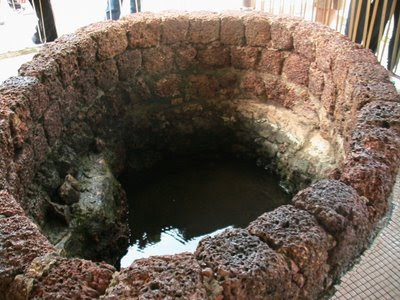A Famosa (Forta De Santiago)
The hallmark of Melaka and perhaps the most photographed subject next to the Stadthuys. Built by the Portuguese in year 1511 as a fortress it sustained severe structural damage during the Dutch Invasion. The British had set to destroy it but timely intervention by Sir Stamford Raffles in 1808 saved what remains of A' Famosa today.
Malacca Sultanate Palace
The Melaka Sultanate Palace (a replica of the Melaka Sultan's palace during the period of the Melaka Sultanate) is located at the foot of St Paul's Hill. The replica was built from information and data obtained from the Malay Annals. These historical documents had references to the construction and the architecture of palaces during the era of Sultan Mansur Syah, who ruled from 1456 to 1477.
Maritime Museum
The Maritime Museum itself is a replica of the 'Flora de La Mar', a Portuguese ship that sank off the coast of Melaka while on its way to Portugal, carrying loot plundered from Melaka. Work on the replica started in early 1990 and it was opened to the public in 1994. The Maritime Museum was officially opened by the Prime Minister Dato Seri Dr. Mahathir Mohamad on June 13, 1994.
Malacca River
Malacca River is a river which flows through the middle Malacca Town in the Malaysian state of Malacca. It was once an important trade route during the heyday of Malacca Sultanate in the 15th century. It has lost most of this function in the present and is a mere tourist attraction.
Kampung Morten
Kampung Morten is located next to the Melaka River (Malacca River) and the only Malay village located in the heart of the Melaka city center. It was named after J.F. Morten, who was the Commissioner of Land in the early 1920's during the early history of the village.Traditional "kampung houses " in the Malacca architectural style can be seen with attractive color schemes.
Cheng Hoon Teng Temple
The Cheng Hoon Teng Temple at Jalan Tokong, Malacca, is the oldest and surely one of the grandest Chinese temples in Malaysia. The temple, with its curved roof ridge, cut-and-paste chien nien decoration, and gable design, reflects the architectural style of South China, of craftsmen from Fujian and Guangdong. It has recently been restored, and in the process garnered a prestigious Unesco award for outstanding architectural restoration.
Hang Li Po Well
Built in 1459 under the royal command of Sultan Mansor Shah for Hang Li Poh, the Chinese princess who married the sultan, the well never dried up during days of old and was the only source of water supply during great droughts. The Dutch enclosed it with stout walls in 1677 to maintain its ultimate into a wishing well and it is said that those who throw coins into it will return to Melaka time and again.
Hang Tuah Well
Located in Kampong Duyong where Hang Tuah spent his childhood among four of his good friends who would later become the famous knights of Melaka. The well is said to be the abode of his soul which takes the apparition of a white crocodile. For a commoner to catch the glimpse of Hang Tuah is hardly likely. It is said that only the holy among us can ever hope to see the apparition.
Christ Church
Standing exactly as it has always been since 1753, the church is testimony to Dutch's architectural ingenuity. Located next to the Stadhuys, its notable feature is the ceiling, whose beams, over 15m (16yd) long, were each made from a single tree. The 200 years old pews are still in evidence. Over the altar, there is a painting of the Last Supper on glazed tiles and on the floors are tombstones in Armenian script.
Clock Tower
This terra-cotta clock tower is located at the Dutch Square, only a stone’s throw away from Stadthuys and Christ Church. This clock tower was donated by Tan Beng Swee.
It was imported from England in 1886. In 1982, the clock was replaced by Japanese made clock, which sparks anger among the elderly residents of Melaka.
Baba & Nyonya Museum
Established in 1896, the Baba-Nyonya Heritage Museum illustrates the way of living of the Peranakans, a unique blend of the east and the west.
It is located at Jalan Tun Tan Cheng Lock, Melaka, and is run by the local Babas (males) and Nyonyas (females).
Queen Victoria Fountain
Right in the middle of the Dutch Square, one will be surprised to see the presence of a British architectural monument the Queen Victoria’s Fountain.
Surrounded by the red-painted heritage buildings constructed during Dutch occupation, the green-colour Queen Victoria’s Fountain of Melaka was built in 1904 by the British to commemorate Her Majesty’s Diamond Jubilee.
Made of English marble, the Queen Victoria’s Fountain is still functioning well today, and is considered as one of the most frequently photographed landmarks in Melaka.













No comments:
Post a Comment